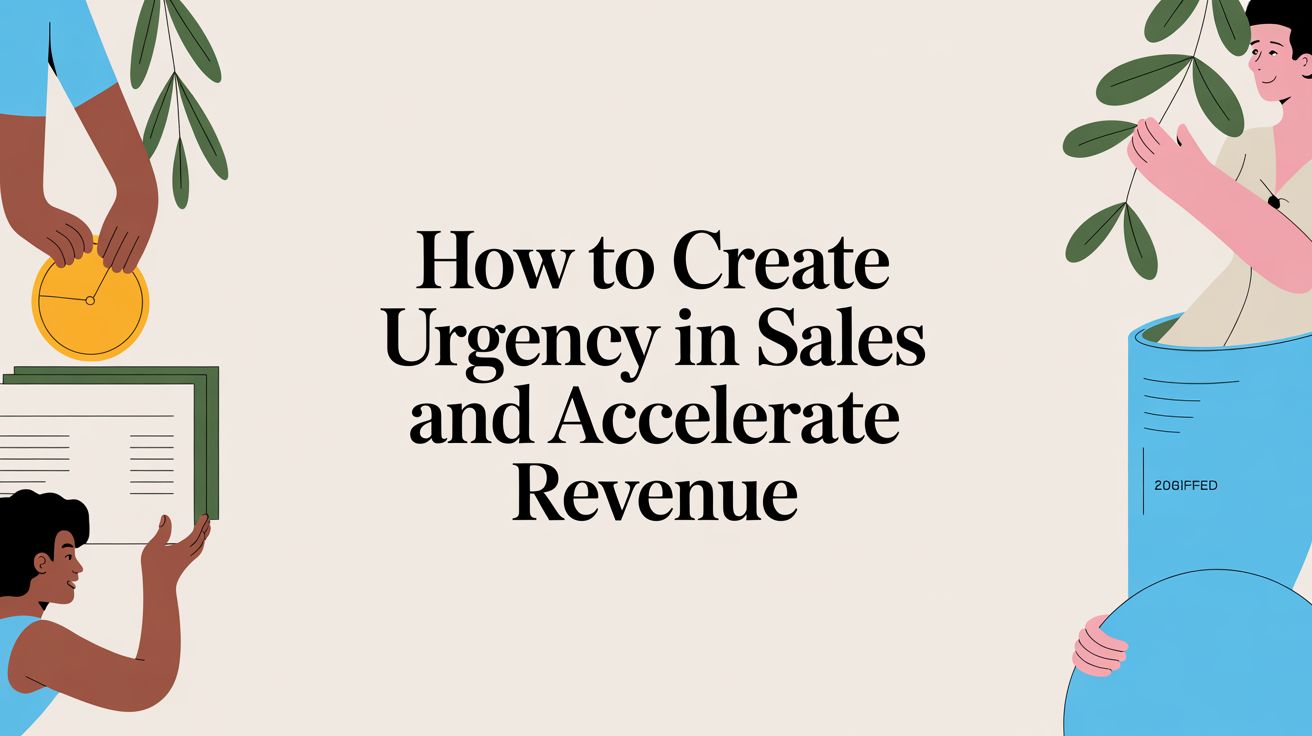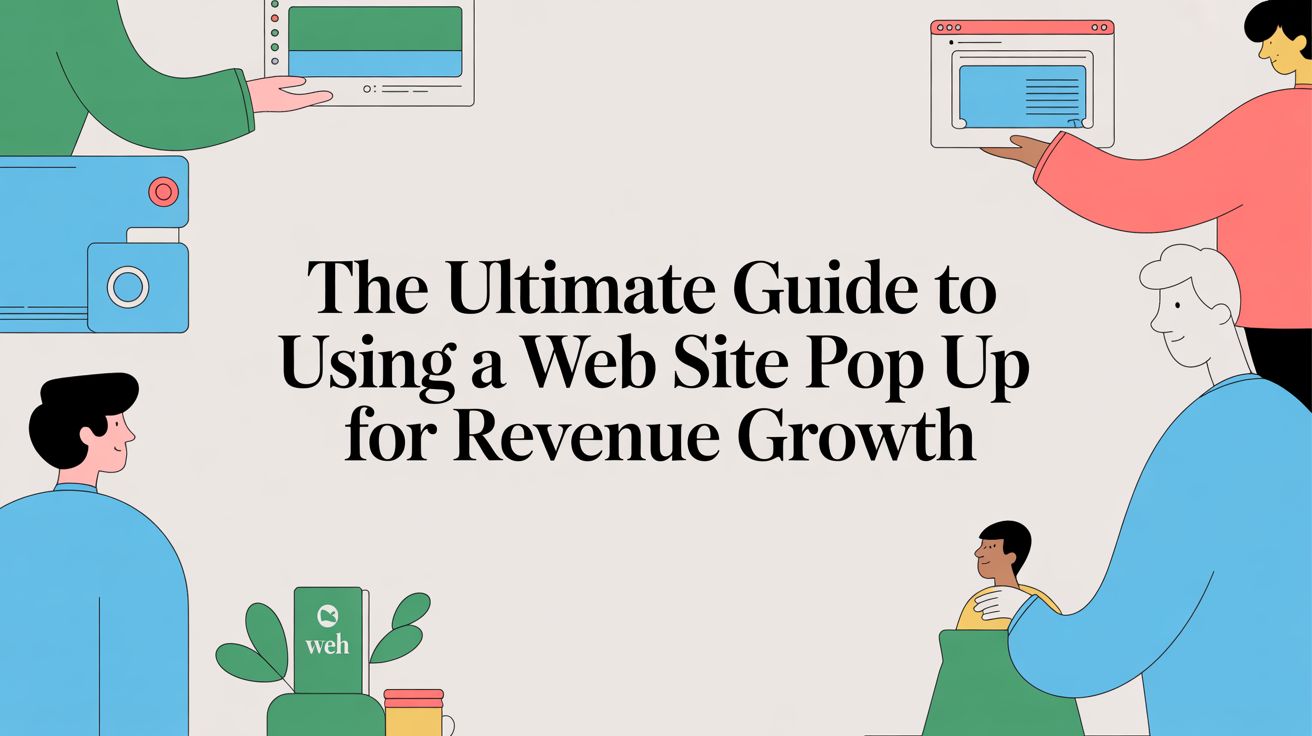
Ecommerce Personalization Software That Drives Revenue
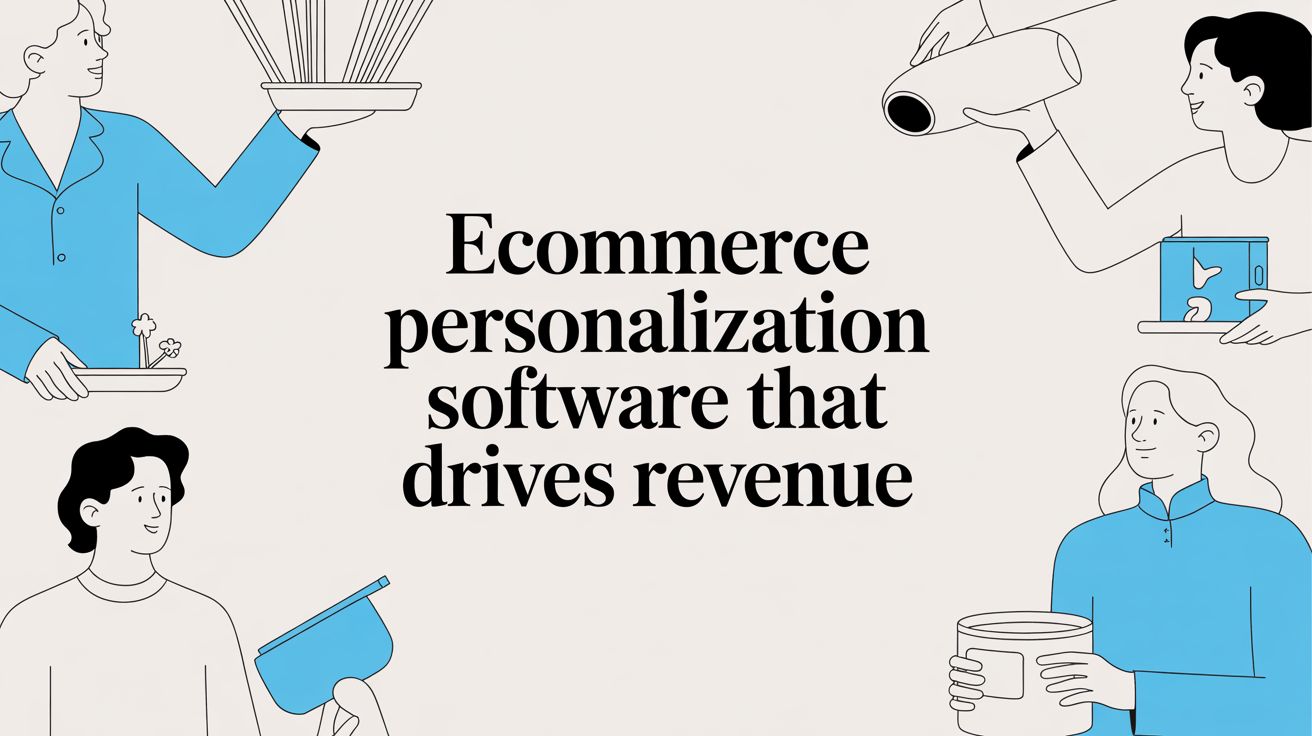
Ever wonder why some online stores feel like they just get you? That's the power of ecommerce personalization software. It's an intelligent system that uses AI and real-time behavioral data—from clicks, searches, and past purchases—to build a shopping experience that feels bespoke. The goal is to dynamically change everything from product recommendations to the banners you see, all to match what a shopper is looking for in that exact moment.
This isn’t just a nice-to-have; it’s a sophisticated strategy to combat the industry's 70% average cart abandonment rate and drive significant revenue growth while protecting profit margins.
What Is Ecommerce Personalization Software
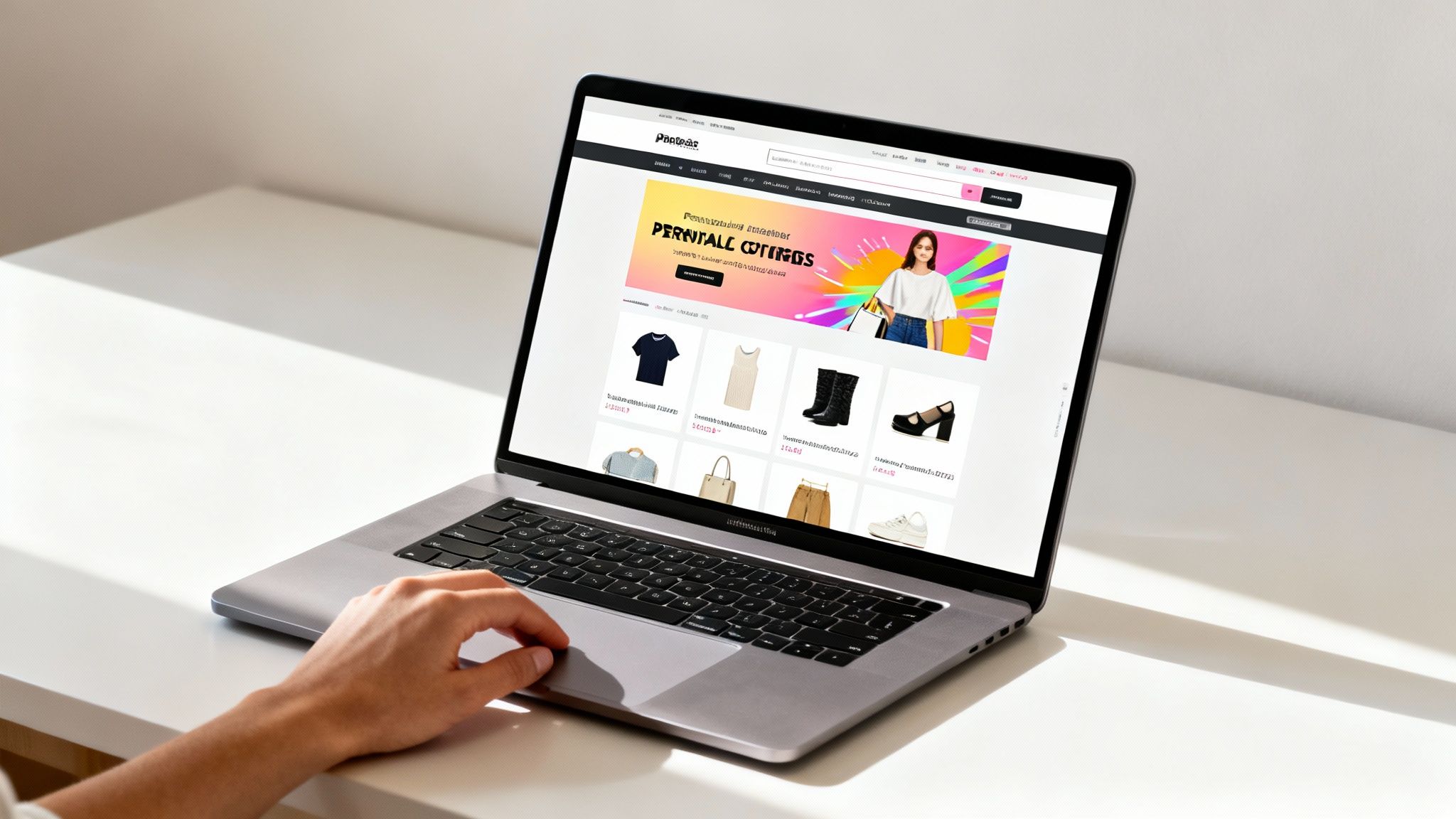
Ecommerce personalization software is an intelligent engine that uses behavioral data, machine learning, and automation to tailor the digital shopping experience to each individual user. Instead of forcing everyone through the same generic digital storefront, these platforms analyze a constant stream of data to craft a journey that feels incredibly relevant, anticipating customer needs and increasing the likelihood of a purchase.
We’ve moved far beyond just dropping a customer's first name into an email. Real personalization means the entire website experience adapts on the fly. If you keep looking at running shoes, the software might automatically feature a banner for a new sneaker drop. If you just bought a tent, it could then suggest compatible sleeping bags. It's intuitive, helpful, and feels less like a website and more like a conversation.
Moving Beyond Basic Marketing Tools
It is critical to distinguish between advanced personalization and the basic marketing tools that have become commonplace. A generic "sign up for our newsletter" pop-up isn't personalization; it’s a one-size-fits-all email capture tool that often interrupts the user experience without adding value. Similarly, a sitewide countdown timer creates broad, impersonal urgency, unlike a targeted message based on an individual's behavior. True personalization is about revenue generation, not just lead capture.
To get a clearer picture, let's contrast basic segmentation with an advanced personalization engine.
Basic Segmentation vs Advanced Personalization
| Attribute | Basic Segmentation | Advanced Personalization Software |
|---|---|---|
| Data Source | Static lists (e.g., location, past purchases) | Real-time behavioral data (clicks, views, searches) |
| Approach | One-to-many (groups of users) | One-to-one (individual users) |
| Experience | Same experience for everyone in a segment | Unique, dynamically changing experience for each visitor |
| Goal | General targeting and broad messaging | Drive individual conversions and increase LTV |
| Example | Emailing a "winter coats" promo to all users in cold climates | Showing a specific coat to a user who has viewed it 3 times |
While segmentation is a foundational starting point, advanced personalization operates on a completely different level. It leverages sophisticated behavioral triggers and principles of consumer psychology to show the right message to the right person when it matters most.
This turns a passive browsing session into an active, engaging journey. The software can spot a high-intent shopper who has viewed the same product three times and automatically present a small, limited-time discount just for that item. This protects your profit margins by avoiding sitewide sales while still closing the deal. This is a foundational part of any modern B2C marketing strategy, which you can explore further in our guide to getting started.
The Business Impact Of A Tailored Experience
The primary purpose of this technology is to drive tangible ROI and protect profitability. Industry benchmarks consistently show cart abandonment hovering around 70%. This is a massive signal that generic experiences are failing. By making the path to purchase feel more natural and relevant, personalization software directly addresses this revenue leakage.
Getting it right involves more than just plugging in a tool; it's about deeply understanding consumer psychology and leveraging personalization for an exceptional website. Data also points to a significant gap between brand perception and customer reality. While 67% of retailers believe they are delivering excellent personalization, only 46% of shoppers agree their experience feels truly personal.
That gap isn't a problem—it's a significant opportunity. It highlights a massive opening for brands willing to invest in genuine, data-driven personalization to stand out from the noise and build the kind of customer loyalty that drives long-term value.
Core Features That Drive Business Growth
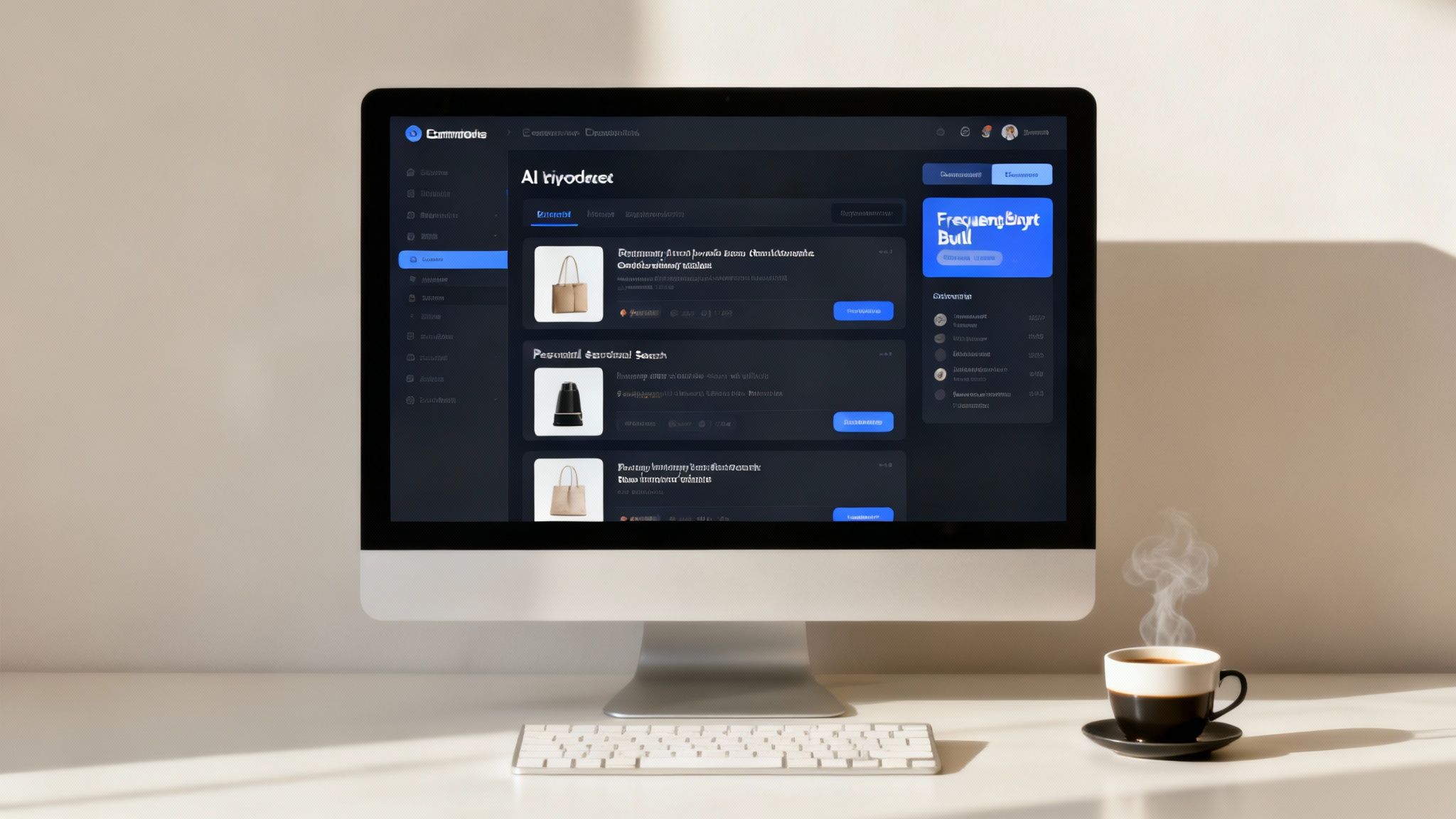
Truly effective ecommerce personalization software is far more than a simple product recommendation widget. It’s a full suite of tools working in concert to directly impact your revenue, profitability, and inventory management.
These features team up to create a shopping journey that feels intuitive, relevant, and compelling. The goal is to convert casual browsers into loyal customers, swapping out generic marketing blasts for precise, psychologically-informed "Moments" that deliver real business results. The best platforms use sophisticated, AI-driven features to anticipate what a shopper needs, presenting the perfect product or message at the exact moment it’s most likely to convert.
AI-Powered Product Recommendations
This is a cornerstone of modern personalization, but it has evolved far beyond clunky "customers also bought" widgets. Today’s AI algorithms analyze a user's entire digital footprint—clicks, searches, dwell time, and purchase history—to serve hyper-relevant suggestions that actively increase cart size.
The entire point is to lift your Average Order Value (AOV). The system gets smart about promoting:
- Strategic Upsells: Suggesting a premium version of the product a customer is already considering.
- Insightful Cross-sells: Offering items that naturally complement a purchase, like a protective case for a new tablet.
- "Frequently Bought Together" Bundles: Grouping products to simplify shopping and increase the total sale value.
Personalized Search and Navigation
A generic search bar is often a conversion killer. When a shopper’s search comes up empty or irrelevant, they bounce. Personalized search flips this experience by adapting to what the user is really looking for in real-time.
For instance, if someone repeatedly searches for "men's hiking boots" on your Shopify store, the software learns. The next time they land on your site, the homepage navigation might automatically spotlight the men's outdoor gear category, reducing friction and shortening their path to purchase. This dynamic adjustment makes your site feel less like a static catalog and more like a helpful concierge.
Key Insight: Personalized search is a conversion machine. 82% of brands agree that a tailored search function is essential for hitting higher conversion rates. It turns a basic utility into a powerful sales tool.
Dynamic Content and Banners
The static, one-size-fits-all homepage is obsolete. With dynamic content, you can swap out banners, headlines, and promotional blocks based on a wealth of data points, creating an immediate connection the moment a visitor arrives.
Consider the ROI-driven possibilities:
- A visitor from a cold climate sees a banner for winter jackets, while someone from a hot, sunny region is shown swimwear.
- A first-time visitor receives a welcome discount, but a VIP customer sees a banner for exclusive "early access" to a new collection, fostering loyalty.
- Banners can be tailored for local holidays or events, building a much stronger regional connection with shoppers.
Behavioral Triggers and Intelligent Pop-ups
This is where personalization becomes a science. We're moving beyond annoying, generic email capture forms that interrupt everyone. Instead, behavioral triggers activate messages based on specific, high-intent actions, transforming pop-ups from interruptions into revenue-generating Moments.
Imagine a shopper is hesitating on the checkout page. A pop-up might appear offering free shipping to nudge them over the finish line. Or if someone has viewed the same product three times, they might get a pop-up with a limited-time offer just for that item. This approach protects your margins by avoiding sitewide discounts and applying urgency only where it’s most effective. This is the sophisticated automation that distinguishes platforms like Quikly from basic timer apps.
The Psychology of High-Converting Personalization
The best ecommerce personalization software does more than just show a customer related products. It taps into core psychological principles—rooted in behavioral economics—that drive human decision-making. When a brand understands the why behind a click, it can craft an experience that feels less like a sales pitch and more like genuinely helpful guidance.
This is the science of turning a casual browser into a confident buyer. Behavioral economics research shows that our choices are often guided by emotional triggers and mental shortcuts, not pure logic. By leveraging these insights ethically, you can create strategies that just feel right.
Leveraging Social Proof and Conformity
One of the most powerful forces in decision-making is social proof. This psychological principle states that when we're unsure what to do, we look to others, assuming their actions reflect the correct behavior. We are hardwired to follow the crowd; it’s a mental shortcut our brains use to validate choices and reduce the anxiety of making a bad decision.
Smart personalization software uses this instinct in subtle but incredibly effective ways. Instead of a generic "bestsellers" list, imagine a banner that tells a visitor, "Shoppers in New York are loving this jacket." Suddenly, the product feels more relevant and trustworthy. It answers the shopper's unspoken question: "Is this a good choice?" By showing that people just like them have already approved, you remove friction and build the confidence needed to click "buy."
This is a world away from a basic app that slaps a "popular" tag on an item. True personalization uses real-time data to make social proof specific and contextual, which makes it far more impactful.
Creating Urgency with Scarcity and FOMO
The Fear Of Missing Out (FOMO) is a potent motivator, directly linked to the principle of scarcity. Consumer psychology studies consistently show that when we perceive something to be rare or in limited supply, its perceived value skyrockets. We are wired to act when we believe we might lose an opportunity.
This is where sophisticated behavioral triggers leave generic countdown timers in the dust. A one-size-fits-all timer creates broad, impersonal pressure. A smart platform, on the other hand, creates urgency that feels personal and justified.
Actionable Takeaway: Identify high-intent shoppers (e.g., those who have viewed the same product 3+ times). On their next visit, display a targeted banner: "Limited stock available for the shoes you viewed. Get them before they're gone."
This message is hyper-relevant and compelling because it connects directly to that person's browsing behavior. It’s not about manipulation; it’s about aligning a real incentive with genuine interest. By using data to spot shoppers on the verge of buying, brands can use urgency strategically to nudge them over the finish line—without resorting to constant, margin-killing sales.
Building Desire Through Anticipation
Another powerful psychological lever is anticipation. The excitement of waiting for something you desire can be more potent than the acquisition itself. Ecommerce brands can tap into this by turning an out-of-stock product from a disappointment into a strategic opportunity.
When a product that a customer has viewed repeatedly is unavailable, a simple "notify me when available" button becomes a powerful tool. Powered by personalization software, this does much more than just capture an email. It’s a strategic move that:
- Secures Future Sales: You prevent a high-intent lead from going to a competitor.
- Gauges Demand: You collect invaluable data on which products are most worth restocking.
- Builds a Relationship: You've turned a negative experience into a positive, forward-looking one.
When that back-in-stock email—perhaps sent via an integrated tool like Klaviyo—finally lands in their inbox, the anticipation has been building. The shopper is primed and far more likely to purchase immediately. You’ve successfully transformed a potential lost sale into a moment that fosters desire and strengthens their brand connection.
How to Choose and Implement Your Personalization Software
Picking the right ecommerce personalization software is a strategic investment that will directly shape your revenue, profitability, and customer retention. It requires a mindset that looks past flashy features to the core technology and how well it aligns with your business goals.
And it's an investment that's quickly becoming non-negotiable.
The global market for this technology is exploding, projected to climb from $263 million in 2023 to a staggering $2.41 billion by 2033. This isn’t a trend; it's a fundamental shift in shopper expectations. They demand shopping journeys that feel made for them. You can read the full research on the ecommerce personalization software market to see just how fast this space is growing.
Key Evaluation Criteria for Your Next Platform
Before signing any contracts, conduct thorough due diligence. Not all personalization tools are created equal, and the technology under the hood can make or break your ROI. For Shopify Plus merchants especially, you need a platform that can handle enterprise-level traffic and complex product catalogs without compromising site speed.
Here are the critical factors to evaluate:
- Scalability and Performance: Can the software grow with you? Ask vendors for case studies from brands with similar traffic, especially during peak periods like Black Friday. A platform that slows down your site is a liability.
- Integration Capabilities: Your personalization engine cannot operate in a silo. It must integrate seamlessly with your entire tech stack. Look for robust, native integrations with key platforms like your email provider (Klaviyo), your SMS platform (Attentive), and your customer data platform.
- AI and Machine Learning Sophistication: This is where the real value lies. Dig deeper than marketing buzzwords. Ask vendors how their algorithms work. Do they rely on simple if-then rules, or do they use true machine learning that adapts in real-time to shopper behavior?
The quality of a platform's AI is what separates a basic tool showing "related products" from a smart one that knows the perfect moment to upsell a customer to a higher-margin item. Success here requires an integrated strategy, and you can learn more by exploring the benefits of a complete ecommerce marketing platform.
The best personalization taps into core psychological drivers to gently guide behavior, as illustrated below.
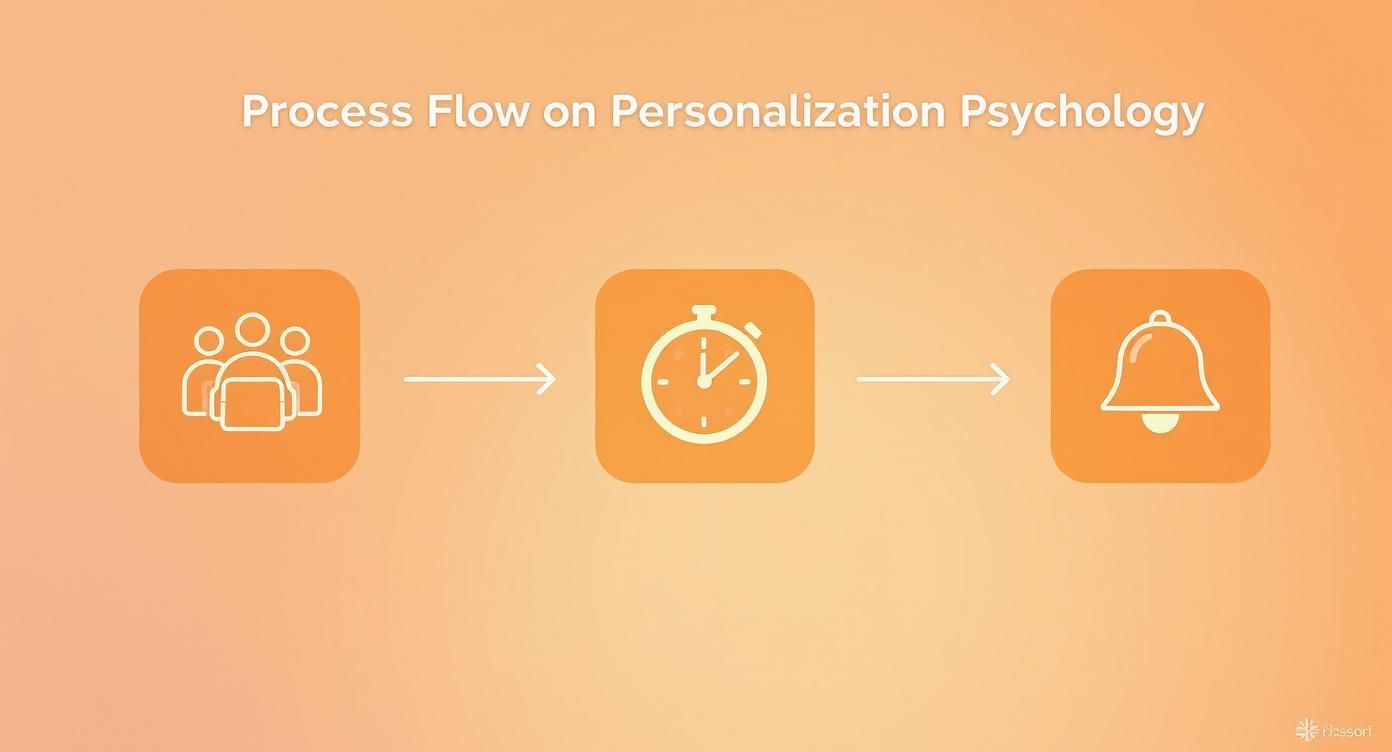
This process shows how a shopper's journey can be shaped by these principles, making the whole experience feel more natural and compelling.
A Phased Implementation Plan for Maximum Impact
Trying to deploy personalization across your entire site at once is a recipe for failure. It's overwhelming, and you'll have no way to measure what’s actually working. Instead, adopt a phased, data-driven approach.
A smart rollout plan might look like this:
- Start with High-Traffic Pages: Begin with your homepage and top product detail pages (PDPs). Use dynamic banners on the homepage for different visitor segments and let AI-powered recommendations on PDPs increase your average order value.
- Move to Cart and Checkout: This is where you combat cart abandonment. Set up targeted behavioral triggers, like a pop-up offering free shipping when a user shows exit intent from the cart page.
- Expand to Category Pages and Search: Personalize product sorting on category pages based on browsing history. Supercharge your site search to show results tailored to individual shoppers to prevent them from bouncing.
- Integrate Across Channels: Finally, connect your on-site experience to your email and SMS campaigns. If someone viewed a specific product category, trigger a follow-up email from Klaviyo showcasing bestsellers from that same category.
Vendor Evaluation Checklist
When you're ready to engage with vendors, arm yourself with these questions to cut through the sales pitch and make an informed decision.
Key Questions for Vendors:
- Can you provide real-world case studies with clear ROI metrics for brands similar to mine?
- What does your onboarding process entail, and what level of technical support is included?
- How does your platform differentiate its strategy for first-time anonymous visitors versus loyal returning customers?
- What is on your roadmap for future features, particularly regarding AI-driven automation and psychological triggers?
Choosing the right ecommerce personalization software is a critical strategic move. By focusing on scalability, quality integrations, and a smart implementation plan, you can turn this investment into a powerful engine for sustainable revenue growth.
Moving Past Conversion Rates: What Really Matters?
It’s easy to fixate on conversion rates as the primary measure of success. But focusing solely on this metric is shortsighted. The real, lasting impact of sophisticated personalization shows up in the long-term health of your business: customer loyalty, growing order sizes, and healthier profit margins.
When you focus on these deeper KPIs, the conversation shifts. Personalization isn’t just a line item in the marketing budget; it becomes a strategic investment in sustainable growth. The market reflects this shift, with some analysts expecting it to surpass $12 billion by 2033 as brands embrace AI. You can dig into more insights on the ecommerce personalization software market to see just how big this shift is.
Tracking Customer Lifetime Value
Customer Lifetime Value (CLV) is the ultimate metric. It’s the single best measure of your business’s long-term health, representing the total revenue you can expect from a customer over their entire relationship with you. This is where personalization truly excels, turning one-time shoppers into brand advocates.
When a customer feels understood—when product recommendations are spot-on and offers are relevant—they have every reason to return. Platforms like Quikly are designed for this. They use behavioral triggers to create loyalty-building "Moments" that go far beyond a simple email pop-up, focusing on long-term value over short-term conversions.
Increasing Average Order Value
Another key metric for your dashboard is Average Order Value (AOV). This tracks how much customers spend per transaction, and personalization software is an AOV-boosting engine. It works by making intelligent, psychologically-driven suggestions that feel helpful, not pushy.
Here’s what this looks like in practice:
- Contextual Upsells: Someone’s viewing a standard backpack. Your site shows them a premium version with better reviews. It’s an upgrade backed by social proof.
- Strategic Cross-sells: A customer adds a coffee maker to their cart. Instantly, they see a suggestion for compatible filters and a best-selling bag of coffee beans. It's a natural add-on that completes their purchase.
These are not random pop-ups. They are calculated recommendations designed to enhance the shopping experience while increasing the cart total.
Optimizing Revenue Per Visitor
For a comprehensive, bird's-eye view, track Revenue Per Visitor (RPV). It blends your conversion rate and your AOV to show how effectively your site turns traffic into revenue. Personalization supercharges RPV by making every visit more valuable, even if a purchase isn't made immediately.
By tailoring the journey for each individual, you increase both the likelihood of a sale and the potential size of that sale. This makes RPV one of the most honest measures of your personalization ROI.
Protecting Profit Margins and Managing Inventory
A frequently overlooked benefit is profit margin protection. Site-wide discounts are a blunt instrument that can erode profitability and devalue your brand. Personalization allows for surgical precision. Instead of a blanket 20% off sale, you can offer a targeted 10% discount on a single item to a shopper who has demonstrated high intent.
The same logic applies to inventory management. Have excess stock of a certain product? Don't slash the price for everyone. Instead, create a personalized campaign that promotes it only to customer segments most likely to be interested. You move aging stock without cheapening your brand, turning a potential loss into a smart, profitable play.
A Few Common Questions About Ecommerce Personalization
When evaluating new technology for your store, key questions around cost, site performance, and data always arise. Addressing these concerns is essential for making a confident decision about what a personalization platform can do for your brand.
How Much Does This Stuff Actually Cost?
The cost of ecommerce personalization software varies significantly. Pricing typically depends on the platform’s sophistication and your store’s monthly traffic volume.
Entry-level tools may cost a few hundred dollars per month. However, for enterprise-level platforms designed for high-volume stores or Shopify Plus merchants, the investment can range from several thousand to tens of thousands of dollars monthly.
The cost reflects the sophistication of the AI, the level of support provided, and the depth of its integration capabilities. When evaluating price, focus on the potential ROI. A platform that costs more but delivers a measurable lift in revenue per visitor and customer lifetime value is a smarter investment than a cheaper tool that fails to move the needle.
Will Personalization Software Slow Down My Site or Tank My SEO?
This is a valid concern—site performance is non-negotiable. Modern, high-quality platforms are architected with this in mind. They use techniques like asynchronous JavaScript, which allows their code to load independently of your main site content, ensuring it doesn't delay page rendering for visitors.
Furthermore, top providers utilize global Content Delivery Networks (CDNs) to serve their scripts from a location physically close to your shopper, minimizing latency. When speaking with a potential provider, ask directly about their impact on Core Web Vitals.
A reputable company will provide clear data or case studies demonstrating minimal performance overhead. They understand that a fast, responsive website is a critical component of a positive customer experience, and their product is built to honor that.
What Kind of Data Do I Need to Get Started?
You can achieve meaningful results almost immediately, even with limited historical data. A good platform begins working the moment it's installed by leveraging real-time behavioral data.
This includes signals like:
- Pages Viewed: Which products and categories are capturing a shopper's attention?
- Products Clicked: What specific items are they investigating?
- Items Added to Cart: This is a powerful signal of intent that can trigger helpful, targeted messages.
The software also analyzes contextual data, such as a visitor's location or referral source. This enables on-the-fly personalization, like showing a banner with products trending in a visitor's city. Over time, as the system gathers more data—like purchase history or information from your CRM or email platform like Klaviyo—the personalization becomes progressively smarter and more accurate.
How Do These Platforms Handle Data Privacy and GDPR?
Data privacy is a foundational element of any trustworthy personalization software. Leading platforms are built from the ground up to comply with major regulations like GDPR in Europe and CCPA in California.
They achieve this in several key ways. First, they typically anonymize user data, removing personal identifiers. Second, they provide clear mechanisms for shoppers to opt out of personalized experiences. Finally, they operate under iron-clad Data Processing Agreements (DPAs) that transparently outline how customer data is managed and secured.
When vetting a solution, always inquire about their compliance features, data encryption protocols, and server locations. Proactive data privacy isn't just about mitigating risk—it's about building trust with your customers and ensuring your personalization efforts are both effective and ethical.
Ready to see how strategically applied urgency can transform your personalization efforts into a revenue-driving machine? With Quikly, you can move beyond basic pop-ups and leverage the science of consumer psychology to increase conversions, protect profit margins, and build lasting customer loyalty. Discover the difference at https://hello.quikly.com.

The Quikly Content Team brings together urgency marketing experts, consumer psychologists, and data analysts who've helped power promotional campaigns since 2012. Drawing from our platform's 70M+ consumer interactions and thousands of successful campaigns, we share evidence-based insights that help brands create promotions that convert.
